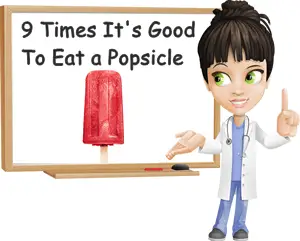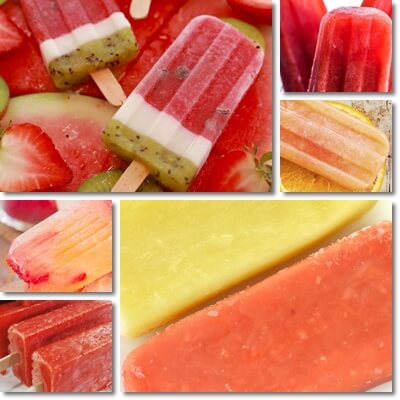Is there ever a bad time to eat a popsicle? Not really, no. But is there ever a good time? Popsicles may not be a powerhouse of nutrition or a source of important benefits for health, but there are times when having one is actually good for you. What are those times? Read on to find out what are 9 instances when you can eat a popsicle and it’s good for you.
1) Have a popsicle when it’s hot outside to help hydrate you
When it’s extremely hot outside and you have to be outdoors in the hot weather, you run a risk of getting dehydrated. High temperatures can cause dehydration fairly quickly, and most people are often unaware they are becoming dehydrated until they are starting to feel faint. Having a popsicle when it’s hot outside can be a really smart move. Popsicles are basically frozen flavored water so they help hydrate you. Given that they’re also sweet, they provide sugars for instant energy and a feeling of vitality.

2) Have a popsicle if your blood sugar is low
A popsicle is a source of sugar, whether added sugar or sugar that exists naturally in fruit and fruit juices. Having one raises blood sugar levels in a matter of minutes and provides almost instant energy. If your blood sugar is low and all you have is a popsicle, then it can really help restore normal glucose levels for a feeling of well being.
3) Have a popsicle as dessert if you are on a weight loss diet
A popsicle is basically flavored frozen water on a stick. It’s generally low in calories, a lot lower than ice cream for example, so it can fit right in into a weight loss diet. While a typical serving of ice cream has around 250 calories, one fruit popsicle has under 100.
Sure, it’s not the powerhouse of nutrition you are told you need, but it is a relatively healthy food option given it’s low in calories and usually has pieces of fruit, mashed fruit or fruit juice.
And it’s definitely better for you than a brownie, a muffin, a donut, a slice of pie or cake or an actual ice cream – it will satisfy your craving for something sweet, but won’t break your diet.

4) Have a popsicle to reduce your calorie intake
A popsicle is typically pretty low in calories. One popsicle at under 100 grams or 100 ml typically has under 100 kilocalories. If it’s fruit flavored, it’s going to have around 60-70 calories. If it’s chocolate or vanilla flavor, it’s going to have around 100 calories. On average, one serving of ice cream will get you around 250 calories, so there’s a big difference in calorie content.
5) Have a popsicle instead of actual ice cream
Which is healthier: a popsicle or ice cream? A popsicle, of course! Popsicles are typically flavored frozen water. They are a lot lower in calories than actual ice cream, lower in sugar and usually fat free.
If made at home, which is totally doable, they can be made to be additive free.
By comparison, ice cream is a lot harder to make at home, it has added sugar and often also unhealthy sweeteners such as corn syrup, preservatives, fat, including hydrogenated fat, and other additives, and also a higher energetic value.
A popsicle is a good compromise for when you crave ice cream, but want something healthier.
6) Have a popsicle if you’re struggling to drink enough water
Plain water, natural mineral water, natural carbonated water, a herbal tea, even fruit juice are better than a popsicle. But if you’re really struggling to drink enough water, then every now and then it can help to just have a popsicle.
A popsicle is really flavored frozen water and can help hydrate you simply because it adds to your intake of fluids. And because it’s sweet, it can make you drink some more water after you eat it (sweet makes you thirsty).
Aside from the water in it that hydrates, there are also electrolytes from fruit that help keep you hydrated and regulate vascular function.
If you are making your own popsicles at home, choose kiwifruit, watermelon or banana puree, orange juice, carrot juice, sweet and sour cherry juice which have magnesium and potassium to boost hydration levels and provide a feeling of well being.
7) Have a popsicle if you’re having nausea
When we have nausea it’s common to crave fluids instead of actual food, especially sweet and tangy flavors from fruit, and something fresh, chilled or frozen. And a popsicle can be all of these things.
A flavorful banana and strawberry, kiwifruit and strawberry, pineapple and mango, or carrot juice and raspberry popsicle can really do the trick. Or if your nausea is bad, you can try a plain orange juice, lemon juice or lime juice flavored water popsicle.
8) Have a popsicle if you’re struggling to eat fruit
It goes without saying that it has to be a fruity popsicle so that you do get some fruit in your diet. Ideally, make it at home either with chunks or slices of your favorite fruit, or fruit purees. Some great tasting options for home made fruit popsicles are:
- kiwifruit and strawberry
- kiwifruit, strawberry and watermelon
- berry puree: blueberry, blackberry, raspberry, strawberry
- pineapple and mango
- pineapple and strawberry
- nectarine, peach or apricot
- carrot and banana
- raspberry and carrot
- cherry and banana
9) Have a popsicle if you are running a fever
A popsicle won’t actually help bring down the fever, but it will help hydrate you and maybe make you feel a little better. When we’re running a fever, it’s important to get as much fluid in as possible, but that can prove difficult because a fever is not conducive to eating or drinking.
But a tangy and sweet, fruity popsicle can be something we can actually eat even with a fever blocking the appetite. It’s not really food so it won’t feel heavy on the stomach, but it will help hydrate and support vascular function with electrolytes, restore energy levels for more vitality, maybe even restore appetite a little.
Flavors such as orange juice and lemon juice can create a sensation of hunger. Pineapple also has vitamin C which favors appetite. Sweet and sour cherry juice, red and black cherry, blackberry and blueberry provide antioxidants with scientifically proven anti-inflammatory effects. While watermelon, orange juice and kiwifruit popsicles provide electrolytes for vascular support.
